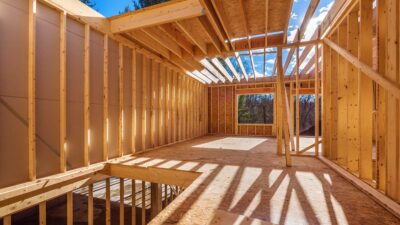Australian Building Standards: A Homeowner’s Guide to Framing
Australian building codes serve as the rulebook for constructing safe and durable buildings in Australia, specifically created to fit the country’s unique conditions. Whether you’re a homeowner or a DIY building enthusiast, it’s crucial to grasp the basics of these codes, as failure to comply can significantly impact your construction process.
This guide breaks down the essential principles and rules of the Australian building standards, focusing on timber framing, roof framing, and wall framing—all explained in simple terms.
Understanding Australian building standards
In Australia, following the building code is vital in ensuring structures’ safety, functionality, and sustainability at both national and state levels, covering various aspects of construction. Safety is always a major concern, and building codes serve as comprehensive guidelines to navigate critical aspects such as structural integrity, fire safety, and electrical installations.
Building codes also serve as a standard for quality assurance, upholding high construction standards. The codes guide the construction of buildings that can withstand diverse conditions, function optimally and have a prolonged lifespan.
Moreover, building codes include sustainability provisions, advocating for the use of energy-efficient materials, sustainable designs, and practices that minimize the environmental impact of construction.
Adherence to building codes is a legal requirement. Failure to comply can result in penalties, project delays, and legal complications.
What are the Australian standards for construction?
The Australian Building Code provides a list of Australian standards for building in the country, and most places follow the National Construction Code (NCC). The NCC outlines details about materials, methods, and standards that builders, contractors, and homeowners must follow.
It’s crucial to familiarise yourself with the key focus areas of the building codes to understand how they place measures, regulations and procedures designed for safety in the construction industry.
Structural integrity is ensured with minimum standards for design and materials, while accessibility guidelines enhance inclusivity. Fire safety measures, such as fire-resistant materials and emergency exits, are crucial for occupant safety.
The guideline also sets standards for building materials, plumbing, sanitation, and electrical installations, ensuring durability, health compliance, and safety.
These Australian standards for building may incorporate green building certifications such as Green Star and NatHERS (Nationwide House Energy Rating Scheme).
The building codes cover energy efficiency, promoting insulation and renewable energy. They also prioritise environmental sustainability through practices like rainwater harvesting and solar panel installations.
Familiarity with these Australian standards in construction is an integral part of building construction for effective and secure practices.
Timber framing standards
The guidelines for timber structures in Australia are outlined in AS 1684, also known as the Timber Framing Code. This regulation has four essential parts covering design criteria, building practices, tie-downs, bracing, and span tables for timber framing members. These are crucial for constructing secure, resilient homes that withstand local wind speeds and weather conditions.
The Timber Framing Code provides a standard reference for product manufacturers and designers to calculate timber sizes and forces, ensuring safety. Parts two and three address building requirements in non-cyclonic and cyclonic areas, while part four simplifies design procedures for lower non-cyclonic wind classes, N1 and N2.
The AS 1684 covers the following:
Timber span tables
These tables, like the AS 1684 span tables, help you figure out the right size and spacing for timber in various applications, providing details on maximum allowable spans for various sizes and grades.
Bearers and joists
Important parts of timber-framed buildings, bearers, and joists’ maximum allowable spans based on timber size and spacing are detailed in the AS 1684 span tables.
Pergolas
For outdoor shade structures, AS 1684 span tables offer insights into the maximum allowable spans for pergolas, depending on the size and spacing of the timber.
Building supplements
Supplements like preservatives and fire retardants, which boost strength and durability, are used to enhance timber structures according to AS 1684 standards.
Basic tolerances
AS 1684 sets acceptable variations in dimensions and levels, guiding allowable tolerances for timber framing, roof framing and wall framing in construction.
Wall framing standards
AS 1648 for timber-framed walls
This is a key guide for timber-framed walls in Australia, encompassing design, construction, materials, wall bracing, fasteners, and finishes.
Roof framing standards
AS 1864 for timber structures
Considered the main standard for timber roof framing, AS 1864 guides design, construction, and materials for roof trusses, rafters, and purlins in Australia.
Related read: Understanding Timber Grades and Classes: What to Know
About AHD Levels
Knowing the Australian Height Datum (AHD) level is crucial in construction. It determines the height of the floor above ground level, serving as a reference point for measuring land and structures.
Ready to build your dream property?
Familiarising yourself with the Australian Building Codes not only guides you in adhering to the necessary regulations but also helps you navigate the complexities of the construction process. To ensure a building that is both aesthetically pleasing and meets safety and functionality standards, do your best to comply with the applicable building codes.
For a more streamlined construction experience, it is advisable to seek assistance from construction professionals. Collaborating with experts can save you time and prevent unforeseen expenses, ensuring seamless execution of your construction project following the Australian Building Codes.
FAQs on Australian building standards
What is the difference between NCC and Australian standards?
While both aim for safety, the National Construction Code is the law across Australia, while Standards are more like voluntary safety suggestions unless specifically referenced in legal documents.
Does NCC reference Australian Standards?
NCC relies on Australian Standards as references. Essentially, the NCC does not include exhaustive details of all design and construction requirements. Instead, it points to other documents, known as NCC-referenced documents, including Australian Standards.
What role do Australian Standards play in the NCC?
Australian Standards provide support to the Building Code of Australia and the National Construction Code, giving specific guidance for compliance and top-notch performance in residential building work. Following these standards is a must for industry professionals, helping create safe, sustainable, and cosy living spaces for Aussie residents.
Which Australian Standards are mandatory?
Standards aren’t laws by default, so there’s no general obligation to follow them. However, if specific laws say you must adhere to a certain standard, like the Work Health and Safety (WHS) laws, failing to do so could mean breaching those laws. WHS laws mandate only a few Standards.
It’s important to recognise that even when not explicitly required, a court may still consider adherence to a standard when evaluating if a duty holder has met WHS laws, especially in certain circumstances.


